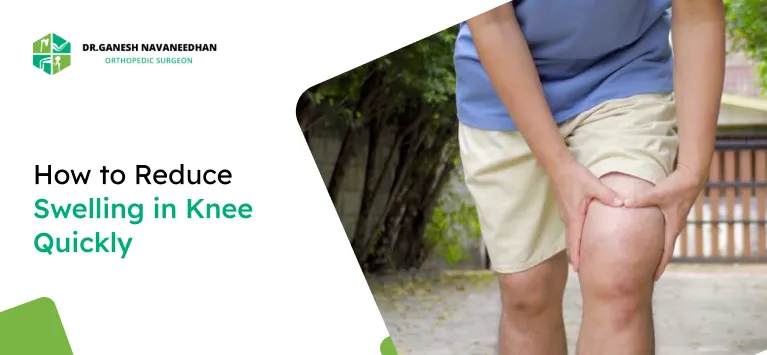- +91 62384 78716 +91 99475 78797
-
Sasthamangalam, Trivandrum
Sasthamangalam, Trivandrum

Knee swelling can be painful and limit daily activities. It may result from injury, overuse, or medical conditions like arthritis. If you’ve ever thought, “My knee is swollen” or “My knee hurts when I bend it and straighten it, but no swelling,” you’re not alone. Many people deal with swelling in knee joints due to various causes. In this blog, we will see how to reduce swelling in knee quickly, understand the causes of knee swelling, explore home remedies for fluid on the knee, and discuss treatment options, exercises, and more.
Knee swelling, also called knee effusion or “water on the knee,” happens when excess fluid builds up in or around the knee joint. Common knee inflammation causes include:
Swollen knee in older persons is often related to degenerative joint diseases, like osteoarthritis. Swelling on the side of the knee with no pain may point to mild fluid accumulation or bursitis. According to the research, 60% of sports injuries involve knee swelling and strain, and according to the Arthritis Foundation, nearly 1 in 5 adults aged 45+ has knee osteoarthritis.
Certain groups are more prone to experiencing swelling in knee:
If my knee is swollen frequently, it could be linked to any of the above conditions.
Definitely, yes, in some cases. Especially if it comes with fever, redness, or inability to bear weight, a swollen knee could signal infection, deep vein thrombosis, or a torn ligament. If swelling is sudden, warm to the touch, and painful, seek immediate care.
Reducing swelling in knee quickly involves a combination of rest, ice, compression, and elevation (R.I.C.E.). This method is effective for short-term swelling relief.
Rest: Avoid putting too much weight on the knee.
Ice: Apply a cold pack for 15-20 minutes every few hours.
Compression: Use an elastic bandage to reduce fluid build-up.
Elevation: Keep your knee above heart level.
Studies show R.I.C.E. can reduce swelling by 30% within 48 hours if applied immediately after injury.
Swelling in knee may last from a few days to several weeks, depending on the cause. Minor injuries heal within a week, while chronic issues or arthritis may cause recurrent knee inflammation. Persistent fluid swelling in knee should be checked by a doctor.
How to reduce swelling in knee quickly home remedies include natural options to reduce inflammation and improve mobility:
These home remedies for knee swelling are cost-effective and safe when used regularly.
Gentle exercises improve blood flow and reduce stiffness:
Quad sets: Tighten thigh muscle while straightening the leg.
Heel slides: Slide heel toward buttock while lying down.
Ankle pumps: Move your foot up and down to improve circulation.
Straight leg raises: Strengthen quadriceps.
Calf stretches: Reduce tightness around the knee.
Perform these 2-3 times daily. Always consult a physiotherapist.
Fluid on the knee remedy depends on the cause. Options include:
These help in both the cure for fluid on knee and fluid swelling in knee. If swelling persists, a doctor might recommend imaging or lab tests.
It is common to have swelling after knee replacement for a few weeks. Use compression stockings, elevate the leg, and do prescribed physiotherapy. Ice and elevation reduce fluid.
The duration depends on the cause:
Persistent swelling beyond two weeks should be evaluated by a doctor.
See a doctor if:
Delaying treatment may worsen knee inflammation causes and result in long-term damage.
A knee pillow helps in:
This is especially helpful for side sleepers and those recovering from knee issues.
According to the research, 70% of patients with arthritis report improved knee function with daily physiotherapy.
If you’re asking “how to reduce swelling in knee quickly,” the answer lies in prompt care, home treatments, and medical advice when needed. Know that swollen knee remedy varies by cause. Whether it’s swelling on the side of the knee with no pain or fluid swelling in knee, proper care makes a big difference. Consider using a knee pillow for sleeping, applying home remedies, and following R.I.C.E. for best results. Stay proactive to prevent knee inflammation.
Apply ice, elevate the leg, use compression, and rest. Avoid strain and overuse until swelling reduces significantly.
Possible reasons include ligament strain, meniscus tear, or bursitis. Pain without swelling often signals internal soft tissue issues.
Try turmeric, ginger tea, apple cider vinegar, massage, cold packs, and rest. These natural remedies support inflammation relief.
Likely causes include tendonitis, cartilage wear, or tracking disorder. Mild joint damage can cause pain without visible swelling.
Manage with rest, elevation, cold therapy, natural remedies, or medical drainage if fluid buildup becomes excessive or persistent.
Yes, it helps reduce joint pressure, improve circulation, and keep the spine aligned during rest, aiding in recovery.
Yes, especially if caused by infection, clot, or serious injury. Signs like fever, redness, or inability to move should prompt immediate medical attention.
Cysts, bursitis, or fluid retention may cause swelling. Even without pain, monitor for changes or worsening symptoms.
It usually persists for weeks. Ice, gentle movement, and elevation help manage post-operative swelling effectively at home.
Cold packs, turmeric, ginger tea, elevation, compression wraps, and massage are helpful natural remedies for knee inflammation.
Fluid on the knee can be dangerous if due to infection or injury. It may cause joint damage if untreated, so consult a doctor for proper evaluation.
Copyright © 2025 Dr. Ganesh Navaneedhan. All Rights Reserved. | Designed By Harvee healthcare